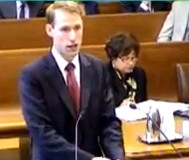1/2/2014
Ninth Circuit Rules Innocent Driving Is SuspiciousAn innocent, noncriminal act of driving is deemed suspicious by Ninth Circuit Court of Appeals ruling.

A combination of non-suspicious driving characteristics can give rise to the suspicion of criminal activity in the opinion of the full Ninth Circuit US Court of Appeals. In a Christmas Eve ruling, the judges weighed whether Border Patrol agents were right to conduct a "border stop" of a red Ford F-150 pickup truck on Interstate 15 while 70 miles north of the border with Mexico.
Border Patrol Agent Luis Lopez spotted the Ford weaving through traffic without signaling, driving about 10 MPH faster than other traffic that day. Agent Jeffery Hays, in a marked Border Patrol vehicle, pulled next to the red truck, but its driver, Rufino Ignacio Valdes-Vega, kept his eyes watching the road ahead. Hays deemed that suspicious. In addition, Hays noted there were no other people in the Ford, which was clean and had Baja California license plates. Agent Hays pulled Valdes-Vega over, but not for traffic violations. He wanted to perform a search of the truck. When he did, he found drugs.
The court was asked to review whether the initial traffic stop was legitimate. Border Patrol agents are allowed to conduct brief investigatory stops if they have a particularized, objective reason to suspect an individual of criminal activity.
"The fact that Valdes-Vega's truck had Mexican license plates made the possibility that it had recently crossed the border significantly more likely," Judge Ronald M. Gould wrote for the court majority. "And the border patrol agents noted that the type of vehicle was significant because trucks are suitable for carrying large amounts of contraband and make it difficult for agents to see into the vehicle."
The court majority concluded that these factors taken together with the slightly fast driving created suspicion that the man behind the wheel was likely to be a smuggler.
"Even innocent, noncriminal acts can foster reasonable suspicion in the total context," Judge Gould wrote. "There is no need for an officer to rule out an innocent explanation. This holds true even if it is far from certain that the suspect is actually engaged in illegal activity."
Three judges disagreed with their colleagues and found it preposterous to find that any combination of factors observed in this particular case would suggest the driver was a criminal.
"Let's cut to the chase," Judge Harry Pregerson wrote in his dissent. "Border patrol agents stopped Valdes-Vega because of his Hispanic appearance... Driving without signaling lane changes and faster than the flow of traffic on a major, busy California interstate highway -- not uncommon in California -- is referred to by the majority as 'perhaps one of the most important factors in the total circumstances here.' Such driving, plus defendant's Hispanic appearance, plus his eyes on the road, plus his driving a clean Ford F-150, plus the Baja plates, did not create a reasonable suspicion that criminal activity was afoot."
A copy of the decision is available in a 100k PDF file at the source link below.


